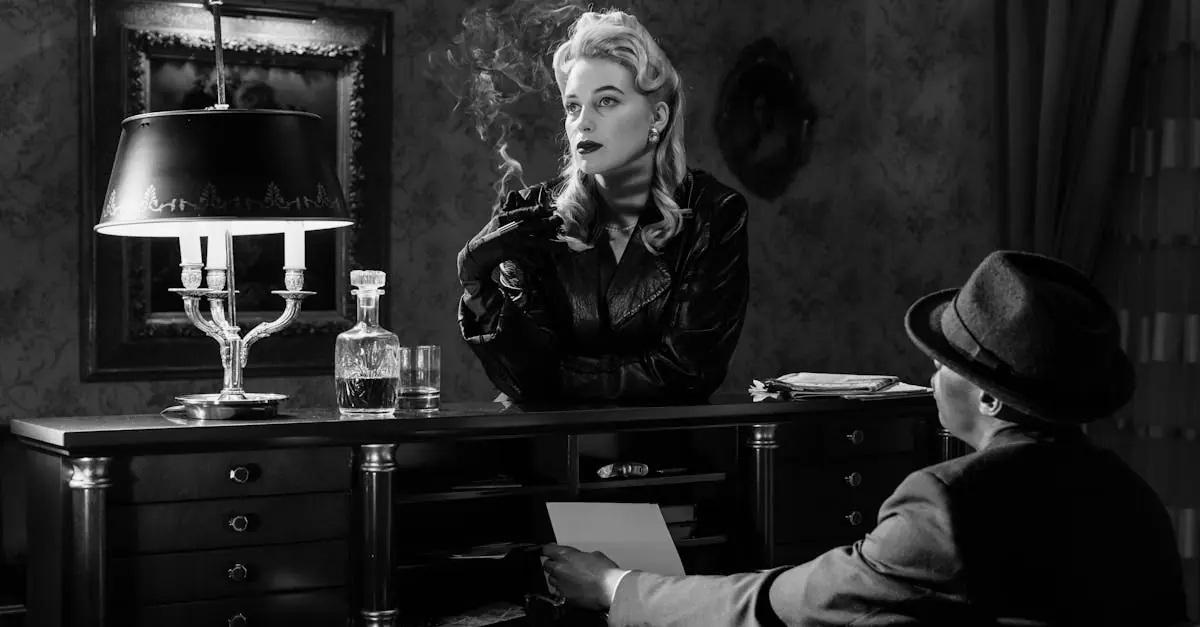Table of Contents
ToggleEvery great movie starts with a plot that hooks you faster than a cat chasing a laser pointer. Whether it’s a heartwarming romance or an edge-of-your-seat thriller, the plot is the backbone that keeps audiences glued to their seats. It’s the intricate dance of characters, conflicts, and resolutions that transforms a simple story into a cinematic masterpiece.
Imagine diving into a world where every twist and turn leaves you gasping for breath, or laughing so hard you spill your popcorn. A well-crafted plot doesn’t just entertain; it sparks conversations, ignites emotions, and sometimes even inspires a midnight binge-watch. So buckle up as we explore the art of storytelling in film, where every plot twist is a delightful surprise waiting to unfold.
Overview of the Plot of a Movie
A movie’s plot serves as the backbone of its narrative structure. Characters interact with each other, leading to conflicts that drive the story forward. Stakes can escalate, engaging viewers and keeping them invested in the characters’ journeys.
Clarity in plot progression enhances audience understanding and emotional engagement. Key elements include exposition, rising action, climax, falling action, and resolution. Each stage plays a vital role in building tension and providing closure.
Conflict types shape the plot significantly. Internal conflicts explore protagonists’ struggles, while external conflicts involve interactions with antagonists or environmental challenges. Resolutions provide satisfaction, answering unresolved questions and offering insights into the characters’ growth.
Subplots enrich the main storyline, adding complexity and depth. They often highlight secondary characters and contribute to the overarching theme. Balanced integration of subplot and main plot ensures a cohesive narrative, preventing distractions.
Plot twists can surprise viewers and shift the narrative direction entirely. These unexpected moments maintain interest and provoke reflection on earlier events. Thoughtfully placed twists enhance storytelling effectiveness, warranting discussions post-viewing.
Engaging plots evoke specific emotions. They can inspire happiness, sadness, fear, or excitement, making the experience memorable. Audiences often resonate with characters facing relatable challenges, prompting them to empathize deeply.
A well-crafted plot intertwines characters, conflicts, and resolutions, forming an intricate tapestry of storytelling that fosters both entertainment and emotional connection.
Key Elements of a Movie Plot
Understanding key elements enhances the appreciation of a movie’s storytelling. Each aspect contributes to a well-rounded narrative that captivates the audience.
Exposition and Setup
Exposition introduces characters, setting, and initial conflicts. It lays the groundwork for the story. Viewers learn essential background information that establishes the context. For example, a film may open with a character’s everyday life, allowing for emotional connections. This setup enhances anticipation and curiosity, preparing the audience for the journey ahead.
Rising Action
Rising action builds tension and excitement through a series of events. Characters face obstacles, leading to conflicts that propel the story forward. Various interactions deepen relationships or create rivalries, intensifying stakes. The unfolding drama keeps viewers engaged. A pivotal point may arise when a character confronts a significant challenge, solidifying their motivations. Each event serves to escalate the story toward its climax.
Climax
Climax represents the turning point of the narrative. It showcases the highest tension and drama, where the central conflict reaches its peak. Characters often make crucial decisions that determine the outcome. A powerful moment might involve a confrontation, revealing true intentions and desires. The emotional investment reaches its zenith as viewers await resolution. This pivotal scene shapes the characters’ journeys and resonates with the audience.
Falling Action and Resolution
Falling action provides a pathway to resolution, addressing consequences of the climax. After intense conflict, the storyline begins to stabilize. Characters reflect on their experiences and make sense of changes. Loose ends are tied up, ensuring clarity in the narrative. Ultimately, resolution delivers a satisfying conclusion, illustrating growth or transformation. Viewers gain closure, leaving behind lingering thoughts or emotions. Each element contributes to a cohesive and engaging plot structure.
Themes and Messages in the Plot
Themes and messages often resonate deeply within the plot of a movie. Connection emerges as a prominent theme, showing how characters relate to each other amid challenges. Conflict highlights personal growth, illustrating that overcoming adversity shapes identity. Redemption frequently serves as a strong message, portraying characters striving for forgiveness and second chances.
Identity exploration plays a crucial role in many narratives. Characters frequently struggle with self-discovery, reflecting broader social themes. The quest for love can also drive the plot, emphasizing how relationships influence choices and perspectives. This theme commonly intertwines with friendship dynamics, revealing how bonds deepen through shared experiences.
Socio-political commentary often surfaces, engaging audiences with pressing issues relevant to contemporary society. Films may tackle themes like inequality, justice, and freedom, prompting viewers to reflect on their beliefs. Environmental concerns increasingly feature in plots, illustrating humanity’s relationship with nature and the consequences of neglect.
Hope emerges as a powerful message, encouraging audiences to persevere despite adversities. This theme often intertwines with resilience, illustrating how characters rise after failure. Unity can also manifest, promoting collaboration among diverse characters to achieve common goals.
Themes and messages within a movie’s plot provide depth and provoke thought. They invite audiences to engage with the story on multiple levels, enriching the cinematic experience. By weaving these elements into the narrative, filmmakers can create compelling stories that resonate far beyond the screen.
Character Development Through the Plot
Character development plays a crucial role in shaping the plot of a movie. As each character faces challenges, their growth often mirrors the narrative’s progression. Through various conflicts, both internal and external, characters reveal their true nature and transformation.
Protagonists tend to evolve the most, as their journeys highlight key themes like redemption and personal growth. Antagonists may also undergo significant changes, offering unexpected depth that enriches the story. Each character’s arc contributes to the overall plot, providing context for their actions and decisions.
Subplots serve as additional pathways for character exploration, often reflecting the main storyline’s themes. For example, a side character’s journey may parallel the protagonist’s, reinforcing themes of friendship or love. Observing these connections can deepen audience engagement and understanding of the primary plot.
Conflict serves as a catalyst for character development. Characters navigated by obstacles demonstrate resilience, encouraging viewers to invest emotionally in their journeys. Emotional stakes raise tension, making character decisions more impactful and relatable.
Character relationships also significantly influence plot dynamics. Friendships and rivalries provide insight into motivations and desires, impacting how events unfold. As inter-character relationships evolve, they can pivot toward resolutions or escalating conflict, further driving the plot forward.
Ultimately, character development through the plot not only enhances storytelling but also fosters a more immersive viewing experience. By aligning character growth with plot structure, filmmakers can craft narratives that resonate deeply with audiences.
A movie’s plot is the heartbeat of its storytelling. It shapes the viewer’s experience and guides emotional engagement through well-crafted characters and conflicts. By intertwining themes and character development, filmmakers create narratives that resonate deeply with audiences.
The intricate layers of a plot not only entertain but also provoke thought and discussion. As viewers connect with characters and their journeys, they find reflections of their own lives and challenges. This connection transforms a simple story into a powerful cinematic experience that lingers long after the credits roll. Ultimately, the plot serves as a vital element that elevates film from mere entertainment to a profound exploration of the human experience.




